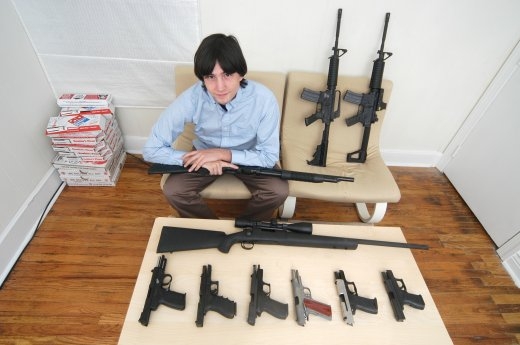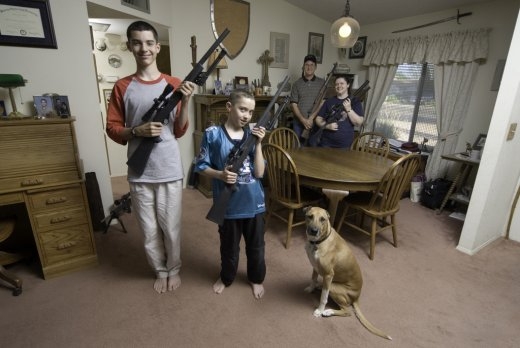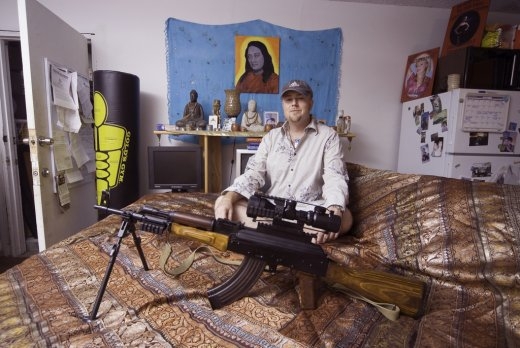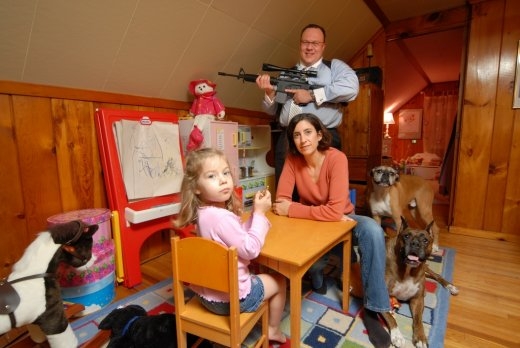
Dan and his Mossberg Model 88, Bushmaster AR-15, Rock Island Armory / Sendra M16, Remington 700 PSS, Springfield XD, FN Five-seveN, H&K USP, Sig Sauer P226, Colt Commander 1911, and Glock 22 by KYLE CASSIDY
Kyle Cassidy has been a freelance writer and photographer since 1999. His photographs have been published in the New York Times, Barron’s Financial, and the Philadelphia Inquirer. He writes frequently about technology and has been an outspoken voice in the area of practical modern photographic theory. Largely known for his fashion and portrait photography, he became interested in photographing gun owners during the 2004 Presidential Election, which resulted in Armed America: Portraits Of Gun Owners In Their Homes. Mr. Cassidy will be at Germ Books tomorrow night to discuss his work.
PHAWKER: What was your view on guns before you started this project?
KYLE CASSIDY: I didn’t really have one — or at least, a cohesive one. Like, if someone asked me about the efficacy of labor unions in the modern workforce — I realize it’s something people feel strongly about, but it’s something I haven’t spent any time thinking about or researching. I certainly didn’t think someone was a bad person just because they owned a gun, but I was also unsure of the reasons that people owned them. Like a lot of people, I guess if you asked me three years ago I would have said “People use guns to hunt, and target shoot, and the police have them.” “Why would someone need a gun in the city?” was really my first thought, “there’s nowhere you can shoot one.” And the whole process was about understanding that — everybody I photographed, I asked the same question: “Why do you own a gun?” Their answers are in the book along with their photographs. I learned there are lots of reasons people own guns that I’d never thought of.
PHAWKER: How has that view changed since you’ve finished the book, if at all?
KC: I realize now that it’s so much more complicated than I’d ever imagined before. Sort of like watching the news and thinking “Gee, the Middle East problem is so easy to solve, the Israelis and the Palestinians just need to get along! Heck, I could fix that in 20 minutes, just let me talk to those guys.” Things that seem simple at the outset become much more difficult when you become aware of all the minutia. One thing I am convinced of, though, is that the two “sides” don’t spend enough time talking to one another and trying to find common ground — they’re too busy making bumper stickers and thinking up clever names to call people who disagree with them. I realized that you will never win an argument that contains the line “you must be an idiot . . .” Hopefully, this book can be a starting point for people to have conversations rather than arguments.

PHAWKER: How did you find gun owners willing to be photographed for the book?
KC: That was really hard at first because I was a completely unknown quantity and a lot of people were like “Oh, yes, of course, another ‘objective journalist’ come to do a ‘completely neutral story’ on us. No thanks.” I was careful to explain to everybody that I wasn’t doing a pro-gun book, but that I wasn’t doing an anti-gun book either, that I was just really interested in their answers and would present them as fairly and honestly as I humanly could. That’s a lot for someone to wrap their head around and it’s an incredible amount of trust that these people needed to put in me. After I had about 10 images together in a portfolio it got a lot easier, because I could just show people, “Here’s what I’m doing” and they could look at it and pretty much right away decide whether or not they wanted to be a part of it — but the first six or eight months was pretty difficult. I had a photography teacher once who taught me that many types of photography have very little to do with f-stops and shutter speeds and lenses, and nearly everything to do with being able to talk to people. I learned just how true that was doing this. (MORE AFTER THE JUMP)
Photographer Kyle Cassidy will speak about his work Tuesday, December 11, 7PM at Germ Books + Gallery, 2005 Frankford Avenue between Rocket Cat Coffee and Circle Thrift, Fishtown, Philadelphia, Pennsylvania, USA
PHAWKER: You’ve said that you didn’t want the photos to be about the guns but about the people, but there are many shots where the guns are front-and-center.
KC: Hopefully, in every picture you could PhotoShop out the guns and still have a compelling portrait and publish a book called “Americans in their Homes” and it would still be interesting — that was my goal and I think I was actually pretty successful. But everybody in the book has a different level of involvement with their firearms. Some had one gun, some had 10, some people interact with them every day, other people haven’t touched theirs for years — one guy had his made into a lamp. Sometimes it was a question of how people actually felt about their guns and whether they’d dragged them all out and arranged them before I got there, or how accessible they were, or what gun had personal meaning to them, but in other instances it had more to do with the aesthetics of their homes. My overall goal was always to make a good portrait. Sometimes the guns became a bigger part of that, other times there were other things, architectural details, pets, children, doorways, whatever, that struck my eye as a photographer. Also some people had sparsely decorated houses, and in other homes there’s a lot going on. So sometimes it’s like “Where’s Waldo”, while other times it’s really easy to spot the gun. Our eyes leap to whatever particular thing based on, I’m sure, a host of things that psychologists could argue about for years — do you notice one type of gun more than another? Does what a person look like have anything to do with how you feel about them having a gun? Is it different if there are children in the photo? What do your eyes gravitate to? Are you looking to see what books they have on their shelves? Are you looking for art on the walls? Do you spot the gun right away? It’s different with everyone. A lot of people flip through the book and say “what’s with all the cats?”

PHAWKER: With all the people you spoke with, was there any one reason for owning a gun that appeared more than others?
KC: Not really. That tended to depend on a lot of things, geography was a big factor. People in rural areas like central Pennsylvania and Wisconsin, for example, tended to be hunters more than people in cities, people who lived in cities often had guns because other people had guns. They were concerned with their personal safety — about someone breaking into their house, or getting carjacked or mugged — those are pretty sweeping generalizations, and most people didn’t have a single reason — a deer hunter might have a home defense shotgun, and someone who carried a gun because he lived in a dangerous neighborhood might also be an avid skeet shooter as well, but where you lived and who your neighbors were seemed to have a lot to do with people’s primary interaction with firearms. Basically there were four categories: self defense, hunting, target shooting, and “keeping the government honest.” Interspersed with that were a lot of “because I can,” you know, “Why do you own a car that can go four times faster than you’re legally allowed to drive it?” “Because I can.” And a lot of people who said they liked the way guns looked or felt a tactile fascination, which makes sense to me — I collect manual typewriters and kitchen stand mixers because I like the way they look and feel. . . . But four broad categories.
PHAWKER: What was the most unusual reason for having a gun that you heard?
KC: I think when I started the most unusual reason I heard was “to keep the government honest.” The idea of owning guns to stop the government from turning totalitarian struck me as unusual but that really turned out to be my ignorance of the gun culture, because it’s an extraordinarily common reason. Everybody’s reasoning fit into some major categories that were echoed by other people. There was a guy who’d had his great grandfather’s pistols made into a lamp, but his house was filled with other antiques, so I didn’t look at the lamp and think “that’s crazy!” There was a Civil War re-enactor in New Jersey who had three huge cannons that were, literally, the size of cars, and it might seem unusual to have three cannons in your garage but he was interested in the Civil War, so it really didn’t seem that odd. I’ve got a Victrola, so I can understand people collecting things because they’re interested in history. There was a guy in Arizona who got his son an AK-47 because the son was about to be sent to Iraq and his father wanted to make sure he knew how to use one in the event he ever needed to pick one up off the ground and defend himself. That’s a pretty unique reason. No one else in the book had said anything remotely similar, but it doesn’t strike me as unusual. In fact, it seems pretty practical.
PHAWKER: You’ve been photographing American culture for long time now. How did this series differ from other series you’ve done, in terms of people you’ve photographed, your methods, etc.?
KC: A lot of my other work on subcultures have been things I’ve exerted a lot of control over. I was making art photos using the elements of these cultures and they had a lot of my own vision in them. I was really controlling of how things were going to look. But in this project I tried to remove myself as much as possible, I didn’t want my artistic fingerprints on it, rather I wanted some kind of straight documentary portraiture. Unlike all of my previous work, I didn’t want this to be about me and my skills as a photographer, I wanted it to be about the subjects, and I wanted to represent them fairly and in as unbiased a way as possible.
When I was photographing Dominatrices, for example, I wasn’t interested in photographing them fairly, we were both in collusion to present something artificial: Here’s how this person looks in an idealized world after two hours of hair and makeup with the most flattering lighting I know how to create, because they work in a world that is heavily made up of fantasy and I was more interested in that than I was in finding out if they sat on the sofa watching “The Price is Right” in sweatpants and curlers.
And also, I was cognizant that gun owners were a group about which there was a lot of pre-existing sentiment so I was very careful of not falling into the easy lure of cheap drama — here’s a family with guns and kids, let’s light them really dramatically and make them look sinister! — that sort of thing. They have kids, they have guns, but they’re also PTA members, grandparents, teachers, neighbors, dog owners, or whatever, so many other facets to their lives, and while I was stringing them all together by the single fact that they were also gun owners, I didn’t want to ever suggest that they were one-dimensional. So there were all these moral obligations I felt as a photographer to be honest that I didn’t think were an issue in my previous work.

PHAWKER: Gun violence is a huge problem in Philadelphia right. There have been over 370 murders this year, and there’s legislation in the Pennsylvania senate regarding how many guns someone can purchase in a month, etc. Did any of the Pennsylvanians you spoke with mention this and if so, how did they react?
KC: First off, I should say that I can’t speak for gun owners and you’d probably get a better answer from someone from the Pennsylvania Firearm Owners Association, but this is certainly something that people talked to me about a lot during my photography and I’m on a few gun-rights mailing lists, so I still hear what people are saying nearly every day.
There were several pieces of Pennsylvania gun legislation that cropped up while I was photographing for this book. What’s interesting about “one gun a month” is that I think most everybody actually agrees on the root issue, which is straw purchases. People with felony convictions are barred from owning or purchasing guns, but they’re getting guns, oftentimes by having someone with a clean record buy one for them. That’s a straw purchase, and it’s illegal. I think you’d be hard-pressed to find a lot of gun owners who think that it should be any other way.
Like any group, gun owners exist along a curve of belief. Some are going to oppose any gun legislation whatever it is, others may be in favor of rather strict gun control, and the rest lie somewhere in the middle.
I’m not a lawyer or a legal scholar so I can only speak anecdotally, but one thing that people repeatedly point out is that the Constitution of the Commonwealth of Pennsylvania is very clear in regards to gun ownership. While the Second Amendment to the U.S. Constitution seems to me to be confusing, as it mentions militias and gun ownership all together, which some people interpret as meaning that it’s the National Guard that has a right to own guns, not private citizens, the Pennsylvania Constitution just says “The right of the citizens to bear arms in defense of themselves and the State shall not be questioned.” That’s it. It deals with the National Guard in an entirely different section. So a lot of Pennsylvania gun owners think that “one gun a month,” regardless of whether or not it would cut down on straw purchases, would be in violation of the Commonwealth’s Constitution. You have the same type of discussion about Michael Nutter’s proposed “stop and frisk” program, [with]some people saying that it will cut down on crime, and other people saying that it’s unconstitutional to stop people and search them without probable cause, and whether or not [doing so] will cut down on crime is irrelevant. I’m sure people will ask “Well, how many guns a month do you need to defend yourself?” but that’s the crux of the argument as I see it.
PHAWKER: Anything else you’ve learned or would like to mention regarding Armed America about the people or your process?
KC: I’ve learned that everybody stereotypes everybody else, even when we think we’re not. Our own emotions and feelings filter
everything that comes in around us. People gravitate towards certain images in the book and make up surprisingly similar stories about who those people are — gun owners and non gun owners alike. I’ve learned that I’ve lived my life in a bubble, surrounded by people who think like I do, and that I’ve been exposed to very few different views of the world. I’ve learned that Mark Twain was right when he said “Travel is fatal to prejudice, bigotry and narrow-mindedness. . . .”
I think everybody ought to take a trip; go somewhere you’ve never been, meet people you never would have met. This summer, get on a bus, or a plane, or get in a car and drive. See the world. It’ll change your life. [AS TOLD TO MAVIS LINNEMANN]
Photographer Kyle Cassidy will speak about his work Tuesday, December 11, 7PM at Germ Books + Gallery, 2005 Frankford Avenue between Rocket Cat Coffee and Circle Thrift, Fishtown, Philadelphia, Pennsylvania, USA
